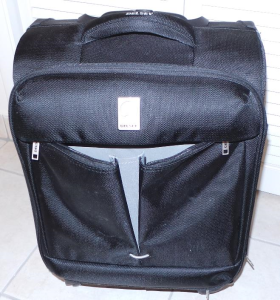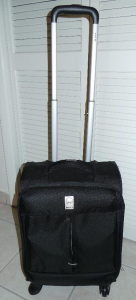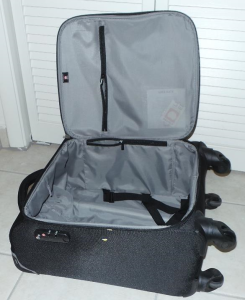I was fortunate to find a first edition copy of Judith Gilford’s book The Packing Book (1994) in my local library and have been reviewing the author’s advice for traveling with just enough personal items to have everything one needs to travel in comfort but without being weighed down with a lot of unnecessary stuff that probably won’t even be used. The author last updated her book in 2006 to include new travel checklists and the latest security-related concerns, but her original material contains her advice about choosing and packing carry-on luggage so that one can enjoy the journey and the destination without being burdened by huge suitcases that are tiring and annoying to have to cart around.
Through my own experience I have realized that traveling light is the best way to go, and for my last visit to London last June I bought a small pull-along wheeled bag that I used as a carry-on. Traveling with such light luggage really added to the sense of go-anywhere freedom that I experienced on that trip. So when I saw Ms. Gilford’s book I was very interested to read the advice of a professional packer. Apart from all the other benefits of traveling with carry-on luggage rather than larger suitcases, to my mind a major benefit of traveling light these days is not having to worry about luggage weight or size and the risk of having to pay additional luggage fees to airlines.
The definition of carry-on luggage may vary from airline to airline, but the author points out that the general upper limit of the size of carry-on luggage is 45 inches (the total of the measured height, width and depth). I did a little research and found that Delta Airlines and American Airlines follow this rule, whereas British Airways allows a maximum size of 50 inches, so it does seem to be a rough industry guideline with some minor variations. This size restriction is used to make sure carry-on luggage can be fit either underneath the seat in front of each passenger or in overhead luggage compartments, to comply with safety standards. The allowed size of carry-on luggage may also vary depending on the type of aircraft, so it is advisable to always check with the airline about the exact size allowed on each flight. If a journey involves different airlines and planes, the traveler should check the luggage requirements for each part of the journey.
I read the author’s guidelines for choosing a 45-inch wheeled bag (which is my preferred type of carry-on luggage) and was delighted to discover that I had made a good choice. The one that I purchased (made by Delsey) prior to my last trip to London has a robust design and is also lightweight; with protected corners and a strong top handle for added durability; a three-sided zipper (required for the packing method described in the book); a large main compartment and two small zippered compartments on the inside; and a large zippered compartment on the outside, which is useful for storing items that might be needed quickly; such as a rain jacket or first-aid supplies. Two big plusses for me with this bag are the telescopic handle that does not use up any of the space in the main compartment, and the four all-way wheels, which are really convenient for navigating the bag though check-in lines at airports.
What clothes the traveler packs will largely depend on the purpose of each trip, but travelers taking only a carry-on bag will need to choose clothes for their “functionality, versatility and style” so that the same clothing can be worn for different circumstances, thus reducing the overall number of clothes that need to be packed. Helpfully, the author provides suggestions for types of clothing (for men and women) that should be packed according to the general categories of minimalist, moderate and luxury clothing requirements. But once a traveler has decided exactly what kind clothes need to be packed, the author recommends the “Bundle Method” to pack the carry-on bag. According to the author, this method “is a packing system [that is] perfect for soft-sided luggage. It creates a cushioned, woven mass of clothing (the bundle) that that does not shift and hardly wrinkles.” When I first read that I thought this method will be worth looking at if I can fit all of the clothes I need in the carry-on without ending up with lots of wrinkled clothes.
The two key features of the Bundle Method are that the packed clothes consist of “a single unit of clothing that takes up the entire space” in the carry-on luggage. The main benefit of this is that the clothes move around less and so are less likely to become wrinkled. The second key feature is that “the bundle has no sharp folds or creases, only soft, cushioned edges.” The bundle is made up of layers of clothing wrapped around an inner cushion, which is a pouch containing underwear, socks and other accessories.
This “inner cushion” also helps to stop the clothes from becoming wrinkled. The Packing Book contains a detailed description of how to select clothes and then how to organize them for turning them into a bundle that will fit inside carry-on luggage in the most economical way (pages 91-95 in the original 1994 edition). It seems like a very scientific and exacting packing method. To be honest, I probably would not follow the author’s every instruction – too perfectionist for me – but I think I could make use of her method as a guideline that I can adapt to improve my own packing. The author also provides a few “shortcuts” that can be used to speed up the packing process and still benefit from the Bundle Method.
In addition to describing her approach to selecting clothes for different types of trips, making the bundle, and packing a carry-on case in layers, the author provides additional advice on packing requirements for business travel, adventure travel, traveling with kids and packing for teens; as well as some advice for traveling safely, including some tips for keeping luggage safe. One of her appendices, “The Top Ten Packing Tips for Carry-on Travelers,” provides a useful summary of the key aspects of traveling light and packing described in her book. One of her tips that I thought was particularly good advice is to mail home souvenirs and other purchases made during travel so that they to do weigh down the traveler.
For more details about the Bundle Method and packing clothes in efficient space-conserving layers, see The Packing Book by Judith Gilford; published by Ten Speed Press.




No comments yet.